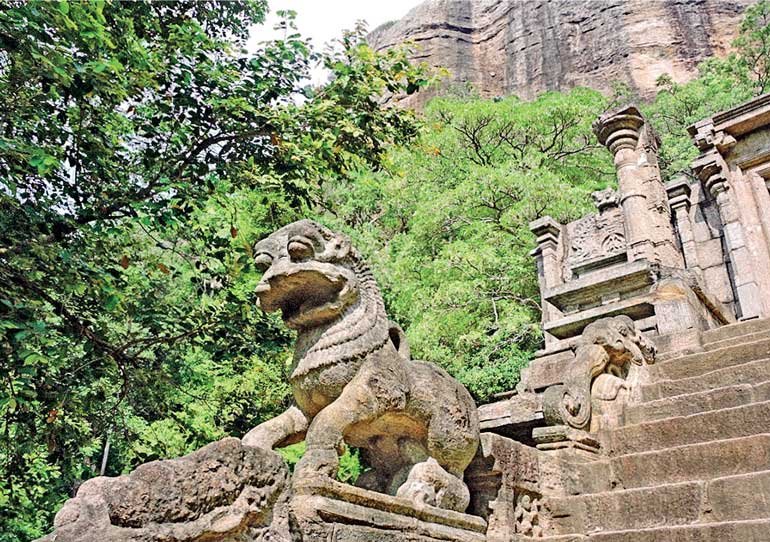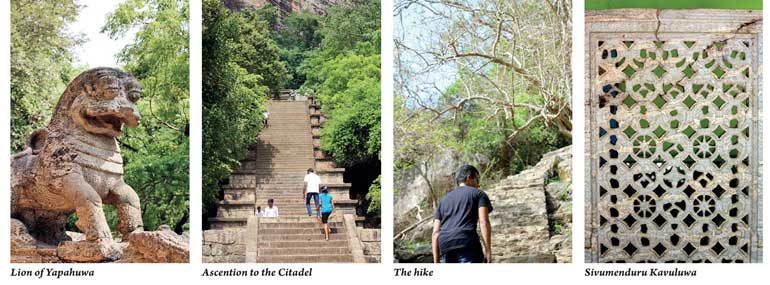Friday Mar 28, 2025
Friday Mar 28, 2025
Saturday, 26 August 2017 00:59 - - {{hitsCtrl.values.hits}}

By Aysha Maryam Cassim
Legends and Bodhivamsa stories reveal that there had been an ‘Alakamandawa’ (A Royal Abode), perched on a rock near Maho, a village situated approximately 45km away from Kurunegala.
During the reign of Kalinga invader Magha (1214-1235) a Sinhalese chieftain named “Subha” built a fortress here, which we know as Yapahuwa today. The present day Yapahuwa was known as Subhapabbata, Sundarapabbata, Sundaeagiri Pavva, Subhacala and Subhagiripura in the ancient scripts.
Yapahuwa holds a significant place in the Sri Lankan history along with its predecessor royal capitals, Anuradhapura and Polonnaruwa. After the decline of the Polonnaruwa kingdom, King Buvanekabahu I took over Yapahuwa in North Western Province as the capital in the 13th century. Even though Yapahuwa remained as the kingdom of the country for a considerably short period of time (1273-1284 BC), the royal capital became a centre for developing the political, economic, religious and cultural orders of Sri Lanka despite many battles and invasions.
The Temple of the Tooth
Following the demise of King Vijayabahu IV, the Sacred Tooth Relic of Buddha was moved from Dambadeniya to Yapahuwa and was enshrined within the temple at the royal residence. It is believed that this temple was constructed during Keerthi Shri Rajasinghe’s reign from 1747-1782 BC.
When the Pandyans captured and plundered the Yapahuwa fortress and carried off all the royal treasures, including the Tooth Relic, it was King Parakramabahu III (1284-1291) who recovered the relic by negotiation.
Vijayabahu III Vs Kalinga Magha
According to Poojawaliya, King Vijayabahu the third launched an adverse militant campaign against Kalinga Magha threats to protect the Sinhala-Buddhist heritage and civilisation. In his book ‘Historical Topography of Ancient and Medieval Ceylon,’ C.W. Nicholas documents King Vijayabahu’s valiant tactics against the South Indian invaders.
“From the fortress, forays were made on the invaders in the occupation of this locality. Vijayabahu III (1232-1236) fixed Salagalkandura as the boundary between his territory and the enemy in the occupation of the northern plain and ordered his sons not to go beyond it. Vijayabahu IV (1271-1273) stationed his son at Subhapabbata to guard the northern plain against invaders. Yapahuva was the scene of the defeat of the Javaka invader, Candabhanu (Sri Dhamma-raja of Tambalinga or Ligor). Thereafter, Vijayabahu IV improved the fortifications, built a rampart and a palace and stationed his younger brother there. Bhuvanekabahu I (1273-1284) transferred his capital from Dambadeniya to Yapahuva and greatly improved the fortress.”

The Stone Stairway in Yapahuwa
In order to reach the ‘Dalanda Maluwa,’ the pilgrim has to climb the rock along a narrow stairway. This can be strenuous as the rock rises to a height of 90 metres and has to be ascended sideways. The summit of Yapahuwa abounds with greenery and unspoilt countryside breeze.
The ornate stone stairway, which leads to the Temple of the Tooth, remains as the most remarkable masterwork in the Royal complex. Originally, this structure comprised three flights of stone stairs, with walls on either sides, depicting graceful female figures.
Among the sculptures at the doorway and rock carvings in the balustrades are the heads of lions, jubilant musicians, dancers and drummers which highlight the influence of South Indian and Cambodian architectural features.
Architectural landscape
Yapahuwa is an ancient rock fortress. Historically, archaeologically and strategically, Yapahuwa is as majestic as the Lion Fortress Sigiriya. Even though the Royal residence, the Temple of Tooth Relic, the battle defences are in ruins, the remnants and traces of ancient defences can still be seen in the Yapahuwa fortress complex.
The landscape of this fortress citadel consists of a rock, inner and outer city, moats, ramparts and a monastic precinct. The fortress is 4m in height and 22m in width. You could find remains of various foundations of buildings, a stupa, ponds, water sprouts, retaining walls and stone steps in the royal premises.
There are 40 caves with the drip-ledges hidden in the monsoonal forests and scrubs. Centuries before Yapahuwa was turned into a Fortress, ascetic monks inhibited these cave shelters and concentrated on the philosophical ideals of Buddhism.

Archaeological excavations
During an 1850 excavation, a fragment of a window called the ‘Sivumenduru Kavuluwa’ was found. Today it is well preserved at the museum in Yapahuwa. The window is a slab of stone, which is four feet in height and seven inches thick. The perforated palace window is adorned with decorative circles, which resemble the tracery work at the Taj Mahal in Agra.
The earliest archaeological excavations in Yapahuwa were commenced under the supervision of H.C. Bell, the first Archaeological Commissioner of Ceylon from 1890 to 1912. During his period, it was discovered that the settlement on the rock was more urban than rural. In 1949, the excavations done in Yapahuwa indicated that Buvenekabahu’s kingdom had close diplomatic and trade ties with China.
Petal Longquan celadon bowl along with two white glazed Dingzhou bowls were uncovered at Yapahuwa in 1911. ‘The Silk Road on Land and Sea’ illustrates in colour the Song dynasty porcelain and coins unearthed in Sri Lanka.
John Carswell writes: “Yapahuwa yielded a hoard of 1,352 coins, including Chinese coins, ranging from 996-1225 A.D.” – Song Blue & White Porcelain on the Silk Road by Adam T. Kessler.